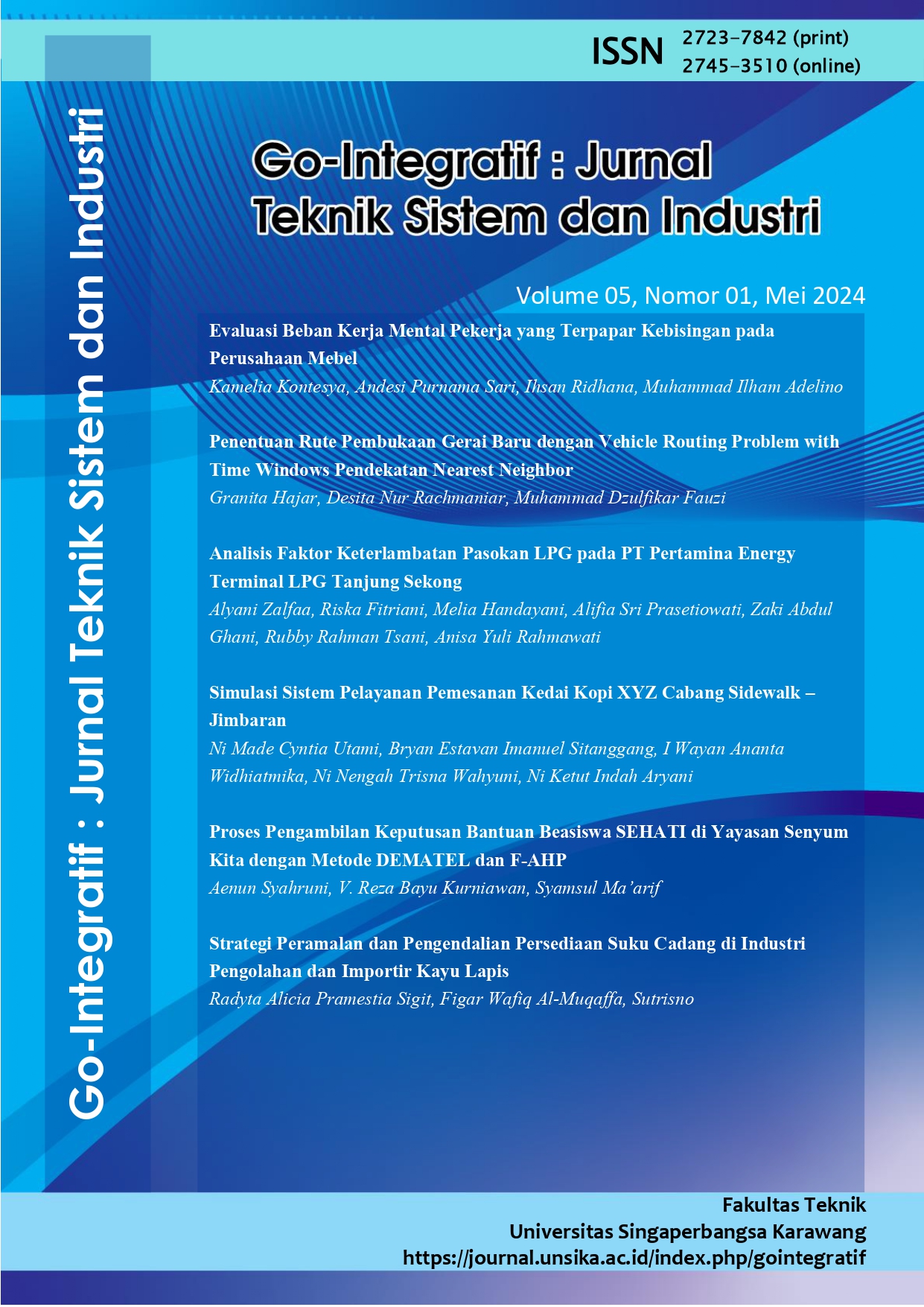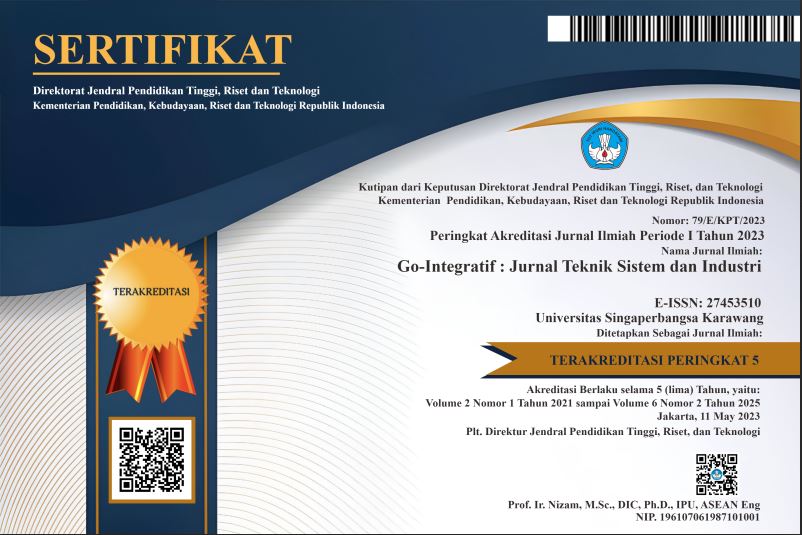Evaluasi Beban Kerja Mental Pekerja yang Terpapar Kebisingan pada Perusahaan Mebel
DOI:
https://doi.org/10.35261/gijtsi.v5i01.11238Abstract
The furniture industry focuses on producing frames, panel doors, windows, and various furniture variations. During its operations, a significant portion of the work involves the use of tools or machines that generate loud noise and require substantial effort. The objective of this research is to identify categories of mental workload on workers and propose feasible improvements. The methods used were the National Aeronautics and Space Administration-Task Load Index (NASA-TLX) and the Rating Scale Mental Effort (RSME). All workers were actively engaged in this study. The results found that all workers were categorized into high and very high levels with a workload score range of 62.67-81.33. The highest influencing indicator was performance (25.45%). These findings were corroborated by the RSME results, where the average score falls within the range of 70-90 out of 150. Based on these results, improvements could be made by increasing the number of workers for job rotation.
Downloads
References
A. Bandono, O. S. Suharyo, and R. Riono, “Aplied Fuzzy and NASA TLX Method to Measure of the Mental Workload,” J Theor Appl Inf Technol, vol. 97, no. 2, pp. 476–489, 2019.
H. D. Siahaan and D. Pramestari, “Analisis Beban Kerja Menggunakan Metode Rating Scale Mental Effort (RSME) dan Modified Cooper Harper (MCH) di PT. Bank X,” Jurnal IKRA-ITH Teknologi, vol. 5, no. 2, pp. 1–16, 2021.
A. Aini et al., “Hubungan Kebisingan Dan Beban Kerja Mental Dengan Stres Kerja di PT. Duraquipt Cemerlang,” Jurnal CMHP, vol. 4, no. 1, pp. 37–48, 2021, [Online]. Available: http://cmhp.lenterakaji.org/index.php/cmhp
A. Rahmawati, “Hubungan Kebisingan dan Beban Kerja Mental dengan Stres Kerja pada Pekerja Bagian Spinning di PT Pamor Spinning Mills,” Jurnal Kesehatan Masyarakat, vol. 11, no. 6, 2022.
N. B. Aranda, A. Sugiono, and A. Syakhroni, “Working Load Analysis Of Mental Operator Web Printing Machine With Job Targets Using National Aeronautics And Space Administartion Task Load Index and Rating Scale Mental Effort at PT. Bawen Mediatama,” JAST : Journal of Applied Science and Technology, vol. 1, no. 2, pp. 2775–4022, 2021.
N. Khairunnisa and H. Prastawa, “Analisis Beban Kerja Mental Menggunakan Nasa-Task Load Index Pada Mesin Napkin Tissue Manual PT The Univenus Serang,” Industrial Engineering Online Journal, vol. 12, no. 4, pp. 1–6, 2023.
A. Syahdhana and M. F. Sufa, “Analisis Beban Kerja Mental dan Kelelahan Pekerja UMKM Abia-Art Menggunakan Metode NASA-TLX dan SOFI,” in Seminar dan Konferensi Nasional IDEC, 2023, p. A15.113-A15.122.
F. T. Yanuar and A. S. Putri, “Analisis Beban Kerja Fisik dan Mental di Pengolahan Furniture Menggunakan Metode CVL dan NASA-TLX,” in Seminar dan Konferensi Nasional IDEC, 2023, pp. 77–86.
D. Satria, T. Tiara, and T. Widjajanto, “Analisis Beban Kerja Fisik Menggunakan Metode Cardiovascular Load Dan Beban Kerja Mental Menggunakan Metode Rating Scale Mental Effort Pada PT Citra Abadi Sejati Bogor,” Jurnal Teknologi dan Manajemen, vol. 21, no. 1, pp. 25–34, 2023.
N. A. Adikarana, D. Herwanto, and M. R. Rifa’i, “Analisis Beban Kerja Mental Menggunakan NASA-TLX pada Divisi Produksi Perusahaan Metal Stamping,” Go-Integratif : Jurnal Teknik Sistem dan Industri, vol. 3, no. 02, pp. 98–109, Nov. 2022, doi: 10.35261/gijtsi.v3i02.7151.
R. Malik, I. N. Afiah, M. Dahlan, Z. Sabara Hw, T. Nur, and R. Iswandi, “Analysis of Rating Scale Mental Effort (RSME) to Determine the Mental Workload of Workers at Sugar Factory in South Sulawesi,” Jurnal Penelitian dan Aplikasi Sistem & Teknik Industri (PASTI), vol. 15, no. 2, pp. 130–136, 2021.
A. Septiani, N. P. Hidajat, and V. Septiawati, “Analisis Beban Kerja Mental dan Kegagalan Kognitif pada Tenaga Kependidikan (Studi kasus: Tenaga Laboran Fakultas Teknik UNISBA),” Jurnal Media Teknik & Sistem Industri, vol. 7, no. 1, pp. 1–9, 2023.
A. T. Rahayu, M. S. Lestari, R. Prasetyo, and I. Sudarno, “Analisis Beban Kerja Mental Menggunakan Metode National Aeronautics And Space Administration Task Load Index (NASA-TLX) Dan Rating Scale Mental Effort (RSME) (Studi Kasus: Balai Pialam Yogyakarta DPU-P ESDM DIY),” in Prosiding Seminar Nasional Aplikasi Sains & Teknologi (SNAST), 2021, pp. 182–188.
K. Moustafa and L. Longo, “Analysing the impact of Machine Learning to model subjective Mental Workload: a case study in third-level education,” in Conference: International Symposium on Human Mental Workload: Models and Applications, 2019, pp. 1–17.
S. Said et al., “Validation Of The Raw National Aeronautics And Space Administration Task Load Index (Nasa-Tlx) Questionnaire To Assess Perceived Workload In Patient Monitoring Tasks: Pooled Analysis Study Using Mixed Models,” J Med Internet Res, vol. 22, no. 9, pp. 1–13, 2020.
S. W. Ismiyasa and I. F. W. Dhari, “Analisis Beban Kerja Mental Pada Pekerja Bangunan,” Prosiding STIKES Bethesda, vol. 2, no. 1, pp. 220–225, 2023.
M. Michael, E. Girsang, L. Chiuman, and A. Adrian, “Beban Kerja Mental Perawat Dengan Metode Rating Scale Mental Effort (RSME),” Window of Health : Jurnal Kesehatan, vol. 5, no. 1, pp. 419–432, 2022.
S. Sari, A. Nuralma, A. R. Feocliamsyah, H. Hafiizh, and P. E. Sunardi, “Pengukuran Beban Kerja Dengan Menggunakan Metode Rating Scale Mental Effort (RSME) (Studi Kasus: Guru SMP XYZ),” Jurnal Kesehatan Masyarakat Dan Lingkungan Hidup, vol. 7, no. 1, pp. 9–20, 2022.
A. Kurniawan, F. Handoko, and E. Adriantantri, “Usulan Penempatan Tenaga Kerja Cleaning Service Berdasarkan Beban Kerja Mental di Rumah Sakit X,” Jurnal Valtech, vol. 3, no. 2, pp. 171–176, 2020.
S. Putra, F. Handoko, and S. Haryanto, “Analisis Beban Kerja Menggunakan Metode Workload Analysis Dalam Penentuan Jumlah Tenaga Kerja Yang Optimal di CV. Jaya Perkasa Teknik, Kota Pasuruan,” Jurnal Valtech, vol. 3, no. 2, pp. 82–85, 2020.
D. Battini, N. Berti, S. Finco, I. Zennaro, and A. Das, “Towards industry 5.0: A multi-objective job rotation model for an inclusive workforce,” Int J Prod Econ, vol. 250, Aug. 2022, doi: 10.1016/j.ijpe.2022.108619.
V. Nino, D. Claudio, and S. M. Monfort, “Evaluating the effect of perceived mental workload on work body postures,” Int J Ind Ergon, vol. 93, Jan. 2023, doi: 10.1016/j.ergon.2022.103399.
F. S. Didin, B. P. Maharani, and I. Mardiono, “Work from home study: mental workload, gender, and calorie needs,” Jurnal Sistem dan Manajemen Industri, vol. 5, no. 1, pp. 1–7, Jun. 2021, doi: 10.30656/jsmi.v5i1.2768.
I. Alimohammadi, Z. Damiri, N. Rahmani, B. Parsazadeh, and R. Yeganeh, “Validity and Reliability of Rating Scale Mental Effort, Integrated Workload Scale, and Overall Workload Scale in Iran,” International Journal of Occupational Hygiene, vol. 11, no. 4, pp. 299–311, 2019, [Online]. Available: http://ijoh.tums.ac.ir
N. Rahdiana, R. Arifin, and A. Hakim, “Pengukuran Beban Kerja Mental di Bagian Perawatan di PT. XYZ Menggunakan Metode NASA-TLX,” Go-Integratif : Jurnal Teknik Sistem dan Industri, vol. 2, no. 01, pp. 1–11, May 2021, doi: 10.35261/gijtsi.v2i01.5076.
R. G. Pratama, J. Hutabarat, and Kiswandono, “Pengukuran Beban Kerja Mental Karyawan Dengan Metode Subjective Workload Assessment Technique (SWAT) Pada Gudang Logistik Di PT. Molindo Inti Gas,” Jurnal Valtech, vol. 3, no. 1, pp. 88–92, 2020.
F. Fitra, L. Susanti, H. Raimona Zadry, and F. Firman, “Investigasi Beban Kerja Mental Pada Pekerja Mekanik Untuk Meningkatkan Produktivitas Kerja di SUZ Dealer Honda Dumai,” Journal of Industrial and Manufacture Engineering, vol. 7, no. 2, pp. 247–257, Nov. 2023, doi: 10.31289/jime.v7i2.10138.
M. I. Adelino, B. Harma, and B. Afrianda, “Evaluasi Beban Kerja Mental Karyawan Dengan Menggunakan Metode DRAWS dan RSME,” Indonesian Journal of Multidisciplinary on Social and Technology, vol. 2, no. 1, pp. 26–31, 2024, doi: 10.31004/ijmst.v2i1.275.
W. B. Santoso, “Pengukuran Beban Kerja Mental Dan Fisik Operator Produksi Pada PT. Wiratama Lusindo Menggunakan Metode Defense Research Agency Workload Scale (DRAWS) dan Cardiovascular Load (CVL),” Kaizen: Management Systems & Industrial Engineering Journal, vol. 4, no. 2, pp. 1–8, 2021.
W. A. M. D. Citra and A. O. T. Devi, “Analisis Beban Kerja Mental Menggunakan Metode NASA-TLX Pada Operator Bagian Sewing Perusahaan Garment Di Yogyakarta,” in Prosiding Seminar Nasional Teknologi Industri Berkelanjutan IV (SENASTITAN IV), 2024, pp. 1–8.
D. Satria, T. Tiara, and T. Widjajanto, “Analisis Beban Kerja Fisik Menggunakan Metode Cardiovascular Load Dan Beban Kerja Mental Menggunakan Metode Rating Scale Mental Effort Pada PT Citra Abadi Sejati Bogor,” Jurnal Teknologi dan Manajemen, vol. 21, no. 1, pp. 25–34, Mar. 2023, doi: 10.52330/jtm.v21i1.77.
B. Sajiwo and D. Winarno, “Penggunaan Metode NASA-TLX dan Fuzzy Logic dalam Penilaian Beban Kerja Mental Pekerja (Studi Kasus: Perusahaan Komponen Otomotif),” Jurnal Penelitian dan Aplikasi Sistem dan Teknik Industri (PASTI), vol. 17, no. 2, pp. 138–149, 2023.
Downloads
Published
How to Cite
Issue
Section
License
Copyright (c) 2024 Kamelia Kontesya, Andesi Purnama Sari, Ihsan Ridhana, Muhammad Ilham Adelino

This work is licensed under a Creative Commons Attribution-NonCommercial-ShareAlike 4.0 International License.







